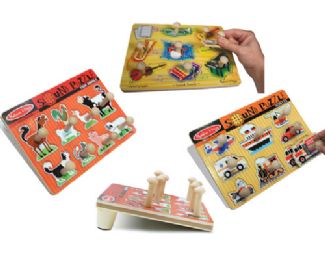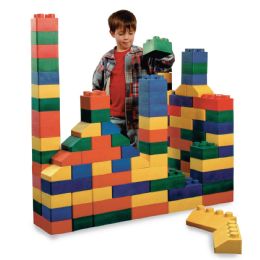
Pediatric manipulatives are games and tools that improve a child’s fine motor skills, gross motor skills, and hand eye coordination. These skills are important in school and social activities as well as in life in general.
Rehabmart is pleased to offer a large assortment of pediatric manipulative tools from top quality vendors including Sammons Preston, Enabling Devices, Southpaw Enterprises, Q3 Enterprises and TFH.









Children learn the best when they are having fun, and having the proper games and tools available will improve their motor skills. Motor skills are movements carried out when the nervous system, brain and muscles work together. Having a variety of toys that stimulate their fine motor skills, gross motor skills, and hand eye coordination is important to children’s development. Adults can benefit from these tools, as well. Their motor skills can become impaired from an illness, injury or stroke.
What are Fine Motor Skills?
Fine motor skills are small movements that use the small muscles of the fingers, wrists, hands, toes, feet, tongue and lips. These include picking up small objects, writing, blinking, and holding a spoon. Fine motor skills affect everyday learning and living. Weaknesses in these skills can affect a person’s ability to write legibly, eat, use a computer, turn pages in a book, and perform personal tasks such as grooming and dressing themselves.
Fine motor skills gradually develop through each stage of a child’s life and throughout their lifetime. They are first seen during a child’s development stages of infancy, toddlerhood, preschool and school age. Basic fine motor skills are typically mastered between the ages of 6 to 12. They will keep developing with age, practice, and increased use of muscles while playing an instrument, playing sports, writing, and using a computer. Occupational therapy can help improve overall fine motor skills if necessary.
Fine motor skills can become impaired from an illness, stroke, injury, cerebral palsy, congenital deformities, and developmental disabilities. Other problems that can have an effect on fine motor skills and decrease movement control are problems with the spinal cord, brain, peripheral nerves, joints or muscles. If a child up to the age of five is not developing their fine motor skills, they will show signs of difficulty in controlling body movements with their fingers, hands and face. A delay in the ability to sit up or learn to walk can also be an early sign of a potential problem. Difficulty with tasks such as drawing lines, cutting with scissors, folding clothes, zipping a zipper, and holding a pencil and writing are also signs. All of these tasks involve their fine motor skills.
What can Help Strengthen Fine Motor Skills?
Many games and toys can help develop and strengthen fine motor skills. These can include games with parts and pieces that have to be picked up and moved in order to play. Remote control cars can be great for school aged kids, as well as video games. Be sure to check the ratings on video games to be age appropriate.
Drawing and coloring can strengthen fine motor skills by using crayons, markers, colored pencils and chalk. Scribbling is fine for this development because it forces the child to hold the item in their hand and control their actions. Paper cutting activities can be as simple or complex as needed, depending on ability and age. Just the act of using scissors is very helpful.
Fidget toys can be a very assistive and effective self-regulation tool. Fidgets and sensory balls can be used to promote focus and concentration, to calm and alert, decrease stress, increase tactile awareness of fingers and hands, and as a way to keep fidgeting fingers busy. They can also provide a fun way to “warm up” the fingers before handwriting activities and tasks, and to strengthen hands. Sensory balls can help relieve stress and keep minds alert.
What are Gross Motor Skills?
Gross motor skills involve the movement and coordination of the arms, legs, and other large body parts, and develop through practice and repetition. These skills include crawling, walking, running, swimming, kicking, sitting upright, lifting, maintaining balance, jumping, and throwing a ball. Gross motor skills depend on both muscle tone and strength. Low muscle tone is a characteristic of several disabling conditions, such as Down syndrome, muscle or genetic disorders, or central nervous system disorders.
Gross motor abilities share connections with other physical functions. The ability to maintain upper body support can affect the ability to write, even though writing is a fine motor skill. Those with poor gross motor development may have difficulty with sitting up in an alert position, sitting erect to watch classroom activities, and writing on a blackboard. A child may need an evaluation by a physical or occupational therapist to determine how severe the problem is and to provide therapy to improve their skills.
Gross motor skills require postural control. Infants need to control their head to stabilize their gaze and to track moving objects with their eyes, and have strength and balance in their legs to walk. Newborns cannot voluntarily control their posture, but within a few weeks they can hold their head upright and soon can lift their head while lying on their stomach. By 2 months old, babies can sit while being supported on a lap or in an infant seat, but cannot sit independently until 6 or 7 months old. At about 8 months old, infants usually learn to pull themselves up and hold onto a chair. The ability to stand develops gradually over the first year, and they can often stand alone around 10 to 12 months old.
There are a range of disorders and diseases that affect a person’s gross motor skill development and skills. In young people, developmental problems, such a muscular dystrophy, genetic disorders, cerebral palsy, and some neurological conditions can highly impact their skill development. Gross motor skills can become impaired from an illness, injury, stroke, or congenital deformity. Developmental coordination disorder affects motor skills, such as holding a pencil, riding a bike, and throwing a ball. Those with this disorder may also have a hard time completing tasks that involve movement of muscle groups in sequence, for example, opening a closet door, getting out a jacket, and putting it on. The symptoms usually go unnoticed until they are diagnosed between 5 and 11 years old.
Some of the important benefits of developing gross motor skills are long-lasting good health that comes from regular physical activity, increased confidence and improved self-esteem that come from being able to successfully take part in games with other kids, release of frustration and stress through physical activity, and improved school skills.
What is Hand Eye Coordination?
Hand eye coordination is the ability of the vision system to coordinate the information it receives through the eyes to guide, control, and direct the hands to accomplish a given task. This task can be catching a ball, drawing, moving wooden blocks, reading music, computer gaming, or handwriting. It is part of performing everyday tasks. In its absence, most people would not be able to carry out the simplest actions.
Between 4 and 14 months old, infants explore their world and develop hand eye coordination that uses their fine motor skills. Infants are eager to move toward the people and objects that interest and comfort them. By 6 months old, they begin reaching for objects quickly, without jerkiness, and may be able to feed themselves simple food. Many are also able to hold one object while looking for another, and follow the movements of their hands with their eyes. After 6 months, infants are usually able to use a cup and hold it by the handle. At about 8 months old, many can grasp small objects, clap and wave their hands, transfer objects from one hand to another, and bang objects together.
Disruption to hand eye coordination can result from numerous disorders, diseases, and impairments. This can include degeneration of the brain due to aging or a disease, damage to the brain itself, vision problems, and movement disorders. Hand eye coordination problems are usually first noticed as a lack of skill in writing or drawing. Such as, when a drawing shows poor orientation on a page and a child is unable to stay within the lines when coloring. Often, they continue to depend on their hands for exploring and inspecting toys and other objects.
Movement disorders are characterized by impaired body movements with a variety of causes. For example, ataxia is characterized by a lack of coordination while a person is performing voluntary movements. Their movements may appear clumsy, inaccurate, and unstable, causing them to seem jerky and not smooth. Another example is hypertonia, which is a condition marked by an abnormal increase in muscle tension and a reduced ability of a muscle to stretch. Whatever their cause, movement disorders almost always prevent the normal development of hand eye coordination.
Hulet Smith, OT
Rehabmart Co-Founder & CEO
lb